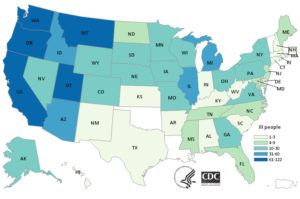 As of August 31, 2020, a total of 1,012 people infected with the outbreak strain of Salmonella Newport have been reported from 47 states.
As of August 31, 2020, a total of 1,012 people infected with the outbreak strain of Salmonella Newport have been reported from 47 states.
Illnesses started on dates ranging from June 19, 2020, to August 11, 2020. Ill people range in age from less than 1 to 102 years, with a median age of 40. Fifty-seven percent of ill people are female. Of 581 ill people with information available, 136 hospitalizations have been reported. No deaths have been reported.
 As of August 31, 2020, there have been 457 confirmed cases of Salmonella Newport illness linked to this outbreak in the following provinces: British Columbia (107), Alberta (257), Saskatchewan (33), Manitoba (25), Ontario (11), Quebec (23) and Prince Edward Island (1).
As of August 31, 2020, there have been 457 confirmed cases of Salmonella Newport illness linked to this outbreak in the following provinces: British Columbia (107), Alberta (257), Saskatchewan (33), Manitoba (25), Ontario (11), Quebec (23) and Prince Edward Island (1).
Individuals became sick between mid-June and early August 2020. Sixty-six individuals have been hospitalized. One individual has died, but it is not known if Salmonella contributed to the cause of death. Individuals who became ill are between 1 and 100 years of age. The majority of cases (55%) are female.
Whole genome sequencing analysis shows that an outbreak of Salmonella Newport infections in Canada is related genetically to this outbreak in the United States. This means that people in both of these outbreaks are likely to share a common source of infection.
Thirty-four illness clusters have been identified in 13 states. Information was collected on 23 of the 34 clusters at restaurants and grocery stores. Information from these clusters shows that many ill people ate red onions and other types of onions. Investigations conducted by states and FDA determined that all 23 restaurants and grocery stores served or sold red, yellow, or white onions. Seventeen of the 23 (74%) served red onions, 13 (57%) served yellow onions, and 10 (43%) served white onions.
The traceback information collected from several of these illness clusters identified Thomson International, Inc., of Bakersfield, California, as a likely source of red onions. Due to the way onions are grown and harvested, other onion types, such as white, yellow, or sweet yellow, are also likely to be contaminated. Traceback is ongoing to determine if other onions are linked to the outbreak.